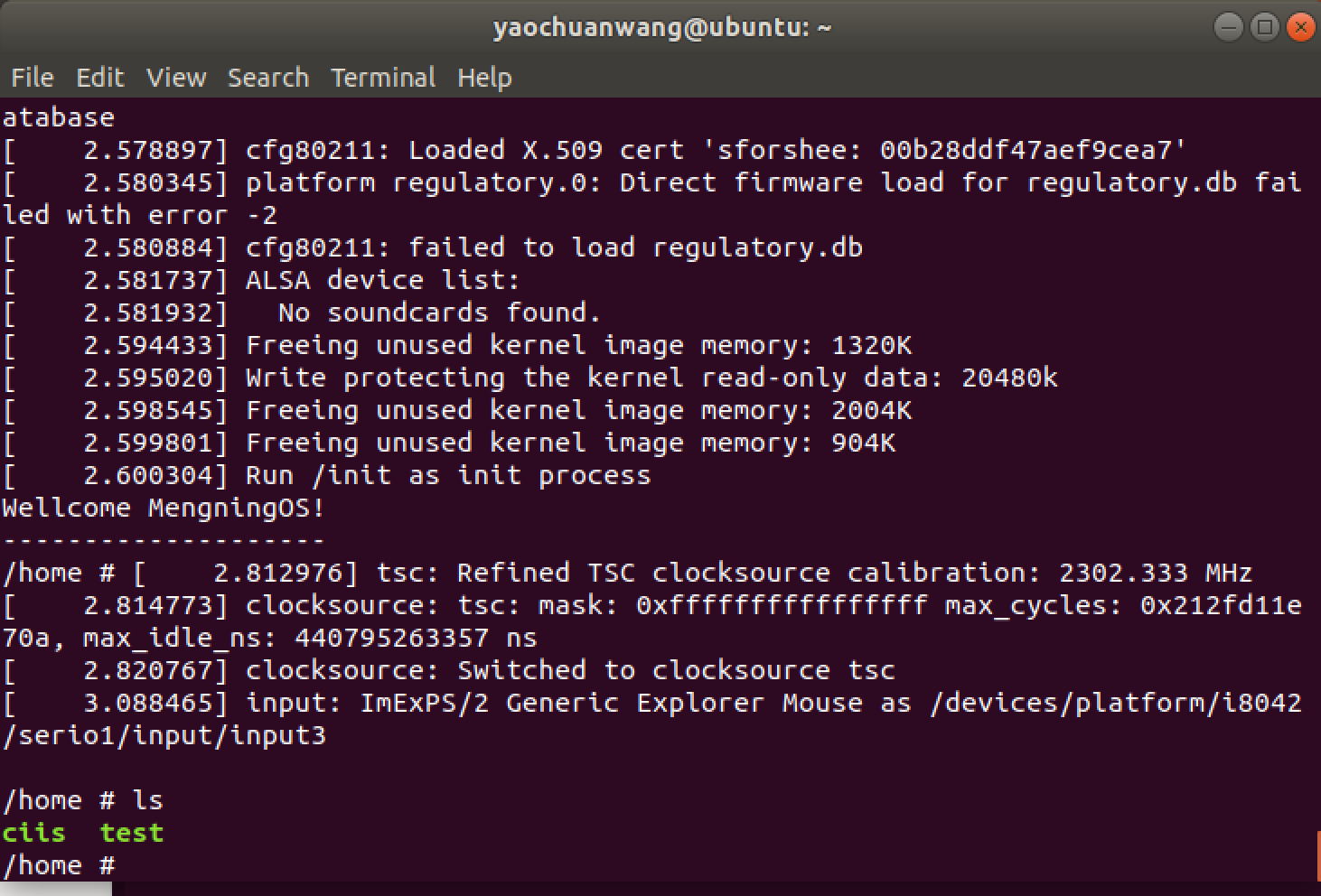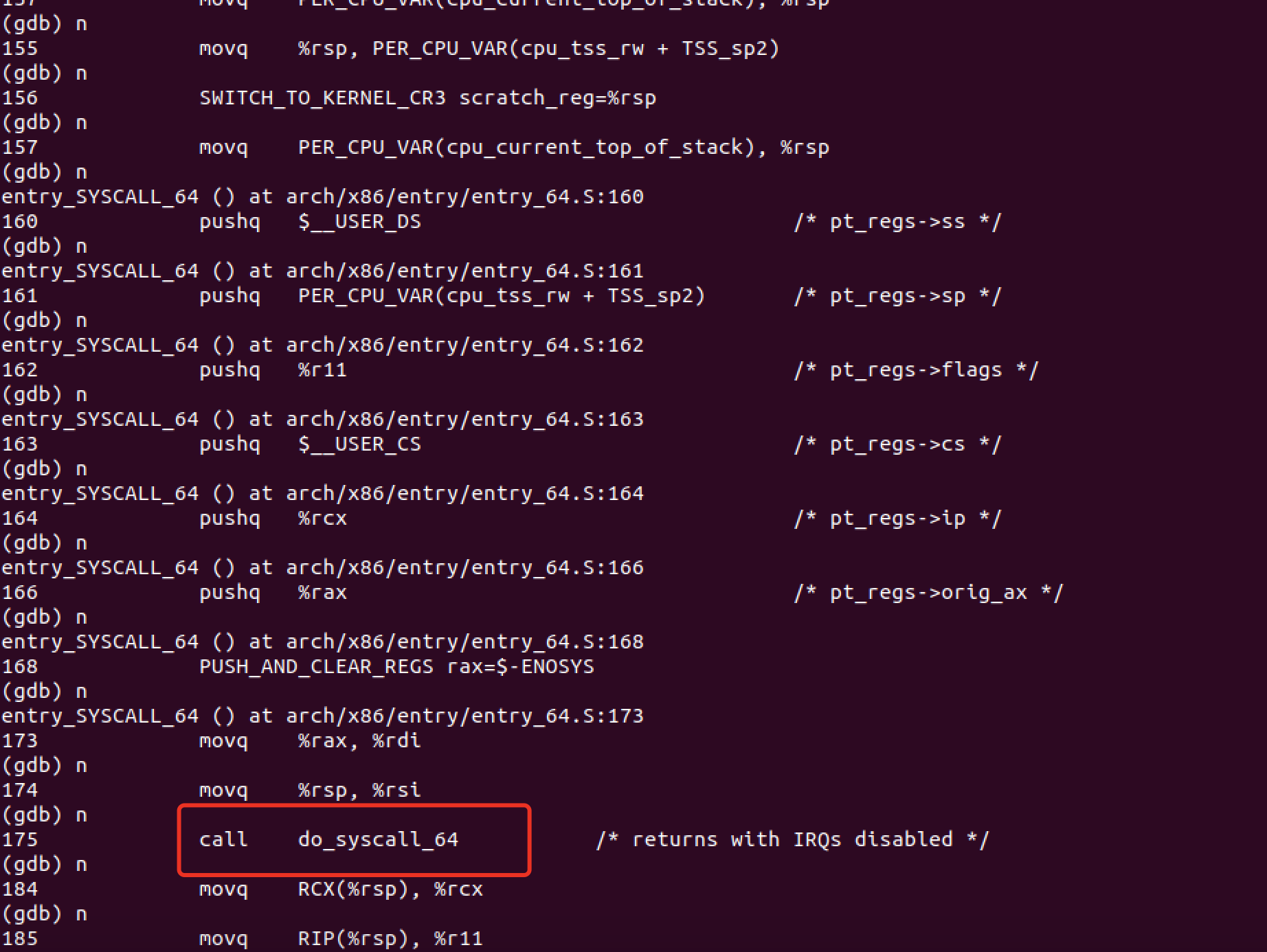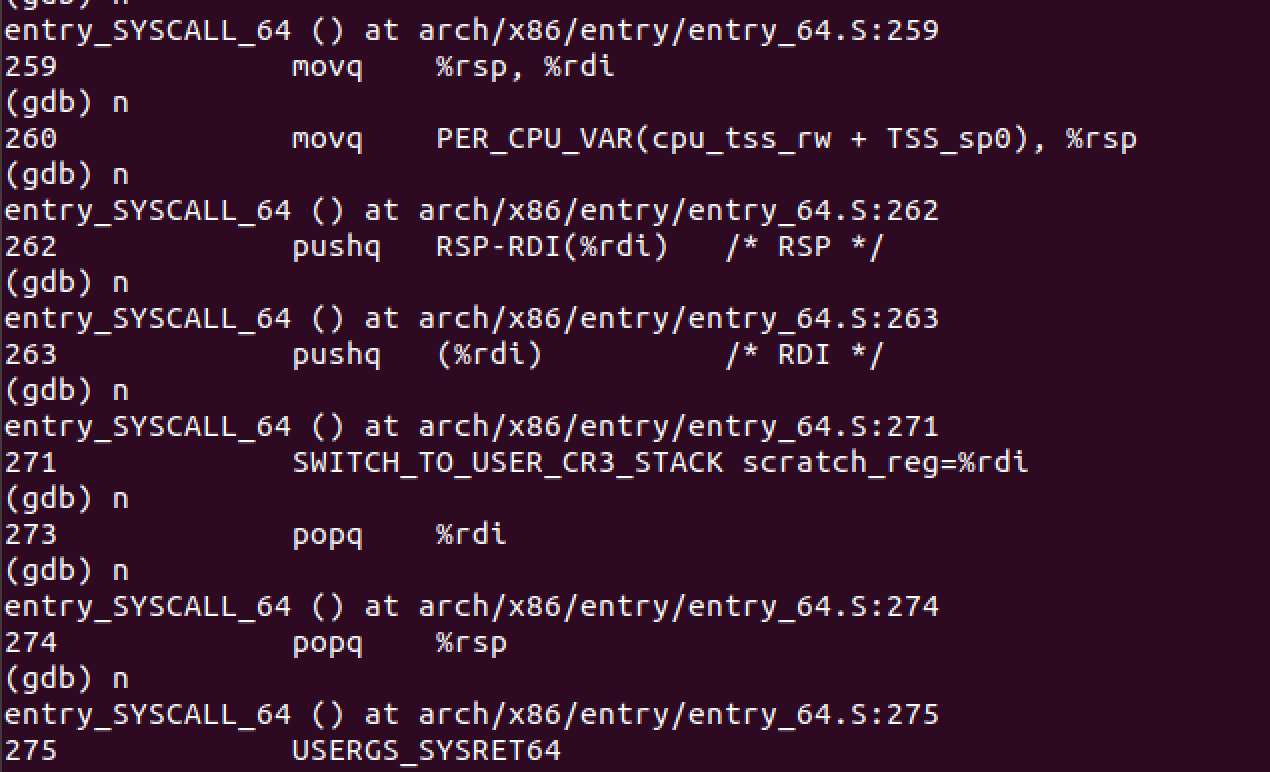一.为何要有系统调用
unix内核分为用户态和内核态,在用户态下程序不内直接访问内核数据结构或者内核程序,只有在内核态下才可访问。请求内核服务的进程使用系统调用的特殊机制,每个系统调用都设置了一组识别进程请求的参数,通过执行CPU指令完成用户态向内核态的转换。
二.系统调用过程
32位系统中,通过int $0x80指令触发系统调用。其中EAX寄存器用于传递系统调用号,参数按顺序赋值给EBX、ECX、EDX、ESI、EDI、EBP这6个寄存器。
下面以64位系统中的42号,connect系统调用作为例子
connect是socket网络通信中的函数,是客户端与服务端连接时所用到的函数,connect接受三个参数,分别是客户端的文件描述符,sockaddr结构体,以及地址长度(ipv4为4)。若成功连接,返回0,否则返回-1
下面是客户端的源代码
#include <sys/socket.h> #include <sys/types.h> #include <netdb.h> #include <stdlib.h> #include <stdio.h> #include <memory.h> #include <unistd.h> #include "rio.h" #define MAXLINE 100 int open_clientfd(char*,char*); int main(int argc,char** argv){ int clientfd; char* host,*port,buf[MAXLINE]; rio_t rio; if(argc != 3){ fprintf(stderr,"usage: %s <host> <port>\n",argv[0]); exit(0); } host = argv[1]; port = argv[2]; clientfd = open_clientfd(host,port); rio_readinitb(&rio,clientfd); while(fgets(buf,MAXLINE,stdin)!=NULL){ rio_writen(clientfd,buf,strlen(buf)); rio_readlineb(&rio,buf,MAXLINE); fputs(buf,stdout); } close(clientfd); exit(0); } int open_clientfd(char* hostname,char* port){ int clientfd; struct addrinfo hints,*listp,*p; memset(&hints,0,sizeof(struct addrinfo)); hints.ai_socktype = SOCK_STREAM; hints.ai_flags = AI_NUMERICSERV; hints.ai_flags |= AI_ADDRCONFIG; getaddrinfo(hostname,port,&hints,&listp); //getaddrinfo会返回所有可用的套接字 for(p=listp;p;p=p->ai_next){ if((clientfd = socket(p->ai_family,p->ai_socktype,p->ai_protocol))<0) continue; if(connect(clientfd,p->ai_addr,p->ai_addrlen)!=-1)//参数分别为客户端的文件描述符,addr地址结构,已经地址长度 break;//成功建立连接 close(clientfd);//建立失败,尝试另一个套接字 } freeaddrinfo(listp); if(!p) return -1; return clientfd; }
服务端是采用基于I/O多路复用的并发事件驱动服务器,基于select函数
1 #include <sys/socket.h> 2 #include <sys/types.h> 3 #include <sys/select.h> 4 #include <netdb.h> 5 #include <stdlib.h> 6 #include <stdio.h> 7 #include <memory.h> 8 #include <unistd.h> 9 #include <errno.h> 10 #include "rio.h" 11 12 #define LISTENQ 1024 13 #define MAXLINE 100 14 15 typedef struct{ 16 int maxfd; 17 fd_set read_set; 18 fd_set ready_set; 19 int nready; 20 int maxi; 21 int clientfd[FD_SETSIZE]; 22 rio_t clientrio[FD_SETSIZE]; 23 }pool; 24 25 int bytes_cnt = 0; 26 27 int open_listenfd(char*); 28 void echo(int); 29 void command(); 30 void init_pool(int,pool*); 31 void add_client(int,pool*); 32 void check_clients(pool*); 33 34 int main(int argc,char** argv){ 35 int listenfd,connfd; 36 socklen_t clientlen; 37 struct sockaddr_storage clientaddr; 38 char client_hostname[MAXLINE]; char client_port[MAXLINE]; 39 static pool pool; 40 41 if(argc != 2){ 42 fprintf(stderr,"usage: %s <port>\n",argv[0]); 43 exit(0); 44 } 45 46 listenfd = open_listenfd(argv[1]); 47 init_pool(listenfd,&pool); 48 49 while(1){ 50 pool.ready_set = pool.read_set; 51 pool.nready = select(pool.maxfd+1,&pool.ready_set,NULL,NULL,NULL); 52 53 if(FD_ISSET(listenfd,&pool.ready_set)){ 54 clientlen = sizeof(struct sockaddr_storage); 55 connfd = accept(listenfd,(struct sockaddr *)&clientaddr,&clientlen); 56 add_client(connfd,&pool); 57 getnameinfo((struct sockaddr *)&clientaddr,clientlen,client_hostname,MAXLINE,client_port,MAXLINE,0); 58 printf("连接到:(%s,%s)\n",client_hostname,client_port); 59 } 60 check_clients(&pool); 61 } 62 } 63 64 int open_listenfd(char* port){ 65 int listenfd; int optval = 1; 66 struct addrinfo hints,*listp,*p; 67 memset(&hints,0,sizeof(struct addrinfo)); 68 hints.ai_socktype = SOCK_STREAM; 69 hints.ai_flags = AI_PASSIVE | AI_ADDRCONFIG; 70 hints.ai_flags |= AI_NUMERICSERV; 71 getaddrinfo(NULL,port,&hints,&listp); 72 for(p=listp;p;p=p->ai_next){ 73 if((listenfd = socket(p->ai_family,p->ai_socktype,p->ai_protocol))<0) 74 continue; 75 setsockopt(listenfd,SOL_SOCKET,SO_REUSEADDR,(const void*)&optval,sizeof(int)); 76 if(bind(listenfd,p->ai_addr,p->ai_addrlen)==0) 77 break; 78 close(listenfd); 79 } 80 freeaddrinfo(listp); 81 if(!p) return -1; 82 //建立成功,开始监听 83 //LISTENQ是等待的连接请求队列 84 if(listen(listenfd,LISTENQ)<0){ 85 close(listenfd); 86 return -1; 87 } 88 return listenfd; 89 } 90 91 void echo(int connfd){ 92 size_t n; 93 char buf[MAXLINE]; 94 rio_t rio; 95 rio_readinitb(&rio,connfd); 96 while((n = rio_readlineb(&rio,buf,MAXLINE)) != 0){ 97 printf("服务器接受到: %d 字节\n",(int)n); 98 printf("%s\n",buf); 99 rio_writen(connfd,buf,n); 100 } 101 } 102 103 void command(){ 104 char buf[MAXLINE]; 105 if(!fgets(buf,MAXLINE,stdin)) 106 exit(0); 107 printf("%s",buf); 108 } 109 110 void init_pool(int listenfd,pool* p){ 111 int i; 112 p->maxi = -1; 113 for(i=0;i<FD_SETSIZE;i++) 114 p->clientfd[i]=-1; 115 p->maxfd = listenfd; 116 FD_ZERO(&p->read_set); 117 FD_SET(listenfd,&p->read_set); 118 } 119 120 void add_client(int connfd,pool* p){ 121 int i; 122 p->nready--; 123 for(i=0;i<FD_SETSIZE;i++){ 124 if(p->clientfd[i]<0){ 125 p->clientfd[i] = connfd; 126 rio_readinitb(&p->clientrio[i],connfd); 127 128 FD_SET(connfd,&p->read_set); 129 if(connfd > p->maxfd) 130 p->maxfd = connfd; 131 if(i > p->maxi) 132 p->maxi = i; 133 break; 134 } 135 } 136 if(i == FD_SETSIZE) 137 printf("add_client error: 客户端过多"); 138 } 139 140 void check_clients(pool* p){ 141 int i,connfd,n; 142 char buf[MAXLINE]; 143 rio_t rio; 144 for(i=0;i<=p->maxi && p->nready>0;i++){ 145 connfd = p->clientfd[i]; 146 rio = p->clientrio[i]; 147 148 if((connfd>0) && (FD_ISSET(connfd,&p->ready_set))){ 149 p->nready--; 150 if((n = rio_readlineb(&rio,buf,MAXLINE))!=0){ 151 bytes_cnt += n; 152 printf("服务器收到 %d (总共%d) 字节 在 文件描述符%d ",n,bytes_cnt,connfd); 153 rio_writen(connfd,buf,n); 154 printf("内容:%s\n",buf); 155 } 156 else{ 157 close(connfd); 158 FD_CLR(connfd,&p->read_set); 159 p->clientfd[i] = -1; 160 } 161 } 162 } 163 }
修改connect函数,以汇编指令的形式进入系统调用
通过gdb查看connect函数传参用到的寄存器

其中connect的系统调用号为0x2a

asm volatile( "movl %1,%%edi\n\t" "movq %2,%%rsi\n\t" "movl %3,%%edx\n\t" "movl $0x2a,%%eax\n\t" "syscall\n\t" "movq %%rax,%0\n\t" :"=m"(ret) :"a"(clientfd),"b"(p->ai_addr),"c"(p->ai_addrlen) );
测试是否通过汇编正常调用connect函数,服务端监听45678端口

客户端试图连接到45678端口

看来是可以正常触发的,其中50962是客户端进程的端口号
接下来重新静态编译客户端程序 gcc clis.c -o ciis -static,如果不是静态编译,在qemu下是不能正常运行的,提示. /not found(缺少lib动态链接库)
然后重新打包系统根目录rootfs
打开qemu,通过gdb在entry_SYSCALL_64处打断点

进入home目录后,执行./ciis localhost 1256
由于每次按下键盘都会触发一个中断,每个中断都会进入断点,所以调试的过程非常慢

进入entry_syscall后,会保存寄存器的值到pt_regs结构体中
ENTRY(entry_SYSCALL_64) UNWIND_HINT_EMPTY /* * Interrupts are off on entry. * We do not frame this tiny irq-off block with TRACE_IRQS_OFF/ON, * it is too small to ever cause noticeable irq latency. */ swapgs /* tss.sp2 is scratch space. */ movq %rsp, PER_CPU_VAR(cpu_tss_rw + TSS_sp2) SWITCH_TO_KERNEL_CR3 scratch_reg=%rsp movq PER_CPU_VAR(cpu_current_top_of_stack), %rsp /* Construct struct pt_regs on stack */ pushq $__USER_DS /* pt_regs->ss */ pushq PER_CPU_VAR(cpu_tss_rw + TSS_sp2) /* pt_regs->sp */ pushq %r11 /* pt_regs->flags */ pushq $__USER_CS /* pt_regs->cs */ pushq %rcx /* pt_regs->ip */ GLOBAL(entry_SYSCALL_64_after_hwframe) pushq %rax /* pt_regs->orig_ax */
进入entry_syscalll_64后,会保存现在寄存器的值放入pt_regs结构体中
继续单步执行,执行call dosyscallc_64函数

do_syscall64定义在common.c中

regs->ax = sys_call_table[nr](regs);
这句会查找对应的系统调用号,然后传入regs结构体,regs中保存着各个寄存器的值,之后会把调用返回值传给ax寄存器
最后会执行sysret指令恢复堆栈

USERGS_SYSERT64是个宏展开,其扩展调用 swapgs 指令交换用户 GS 和内核GS, sysret 指令执行从系统调用处理退出
至此,一段系统调用结束
总结
操作系统对于中断处理流程一般为:
- 关中断:CPU关闭中段响应,即不再接受其它外部中断请求
- 保存断点:将发生中断处的指令地址压入堆栈,以使中断处理完后能正确地返回。
- 识别中断源:CPU识别中断的来源,确定中断类型号,从而找到相应的中断服务程序的入口地址。
- 保护现场所:将发生中断处理有关寄存器(中断服务程序中要使用的寄存器)以及标志寄存器的内存压入堆栈。
- 执行中断服务程序:转到中断服务程序入口开始执行,可在适当时刻重新开放中断,以便允许响应较高优先级的外部中断。
- 恢复现场并返回:把“保护现场”时压入堆栈的信息弹回原寄存器,然后执行中断返回指令(IRET),从而返回主程序继续运行。
在内核初始化时,会执行trap_init函数,把中断向量表拷贝到指定位置,syscall_64.c中定义着系统调用表sys_call_table,在cpu_init时完成初始化。执行int 0x80时,硬件找到在中断描述符表中的表项,在自动切换到内核栈 (tss.ss0 : tss.esp0) 后根据中断描述符的 segment selector 在 GDT / LDT 中找到对应的段描述符,从段描述符拿到段的基址,加载到 cs ,将 offset 加载到 eip。最后硬件将 ss / sp / eflags / cs / ip / error code 依次压到内核栈。返回时,iret 将先前压栈的 ss / sp / eflags / cs / ip 弹出,恢复用户态调用时的寄存器上下文。
syscall则是64位系统中,为了加速系统调用通过引入新的 MSR 来存放内核态的代码和栈的段号和偏移量,从而实现快速跳转。
